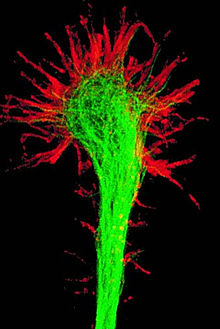Neuroangiogenesis
Neuroangiogenesis is the coordinated growth of nerves and blood vessels.[1] The nervous and blood vessel systems share guidance cues and cell-surface receptors allowing for this synchronised growth. The term neuroangiogenesis only came into use in 2002[2] and the process was previously known as neurovascular patterning. The combination of neurogenesis and angiogenesis is an essential part of embryonic development and early life.[3] It is thought to have a role in pathologies such as endometriosis,[4] brain tumors,[5] and Alzheimer's disease.[6]
Physiology
Neurovascular patterning
Neurovascular development is the parallel emergence and patterning of the nervous system and the vascular system during embryogenesis and early life.
Mechanisms
Neuroangiogenic and axonal guidance molecules act on both
Neuronal growth cones are situated on the tips of nerve cells and are responsive to different factors, both positive and negative. Growth of the neuron occurs by an extension of the actin (red in image) and microtubule (green in image) cytoskeleton.[8]

Tip cells found at the extremity of the developing blood vessel control adjacent endothelial cells to direct growth. Tip cells have receptors and ligands via which they respond to local neuroangiogenic factors.[8]
Neurogenic factors
There are many neuroangiogenic factors, some of which act to promote neuronal growth and vice versa.[5] The table shows examples
| Neuroangiogenic factor | Effect on neuron | Effect on vascular endothelial cells | Receptor/Ligand | Origin |
|---|---|---|---|---|
| IGF-1 | Promotion of neurogenesis and synaptogenesis | EC proliferation, migration, and differentiation | Ligand | Liver cells |
| bFGF | Proliferation of cortical progenitors and neurogenesis | EC proliferation, migration, and differentiation | Ligand | Adipocytes
|
| NGF | Neuron survival, differentiation | Promotion of ischemic hindlimbs |
Ligand | Multiple |
| Neuropilin | Axon guidance | Synergistic action of VEGF165 in EC migration and proliferation Vascular development |
Receptor | Target cell |
| VEGF | Neuronal development and patterning, and has neuroprotective effects |
Induces angiogenesis, promotes endothelial cell survival, proliferation and migration |
Ligand | Multiple |
Pathology
Neuroangiogenesis is implicated in a number of pathologies, including endometriosis,
Endometriosis
Brain tumors
Brain tumors, such as
Brain injury
Following
Alzheimer’s disease
A condition possibly resulting from a reduction in neuroangiogenic factors is Alzheimer’s disease. Without continued neuroangiogenesis during aging, areas of the brain may no longer have the full complement of functional
See also
References
- PMID 25051436.
- ^ Park; et al. (2002). "Delayed Up-regulation of Vascular Endothelial Growth Factor and flk-1 after Global Cerebral Ischemia in Mongolian Gerbil -Possible roles in neuroangiogenesis?" (PDF). Korean Neurological Association. Retrieved 30 September 2015.
- ^ PMID 19363295.
- ^ PMID 21054165.
- ^ PMID 24760128.
- ^ PMID 22850316.
- PMID 12618135.
- ^ PMID 14592405.
- PMID 24859987.
- PMID 27392865.
